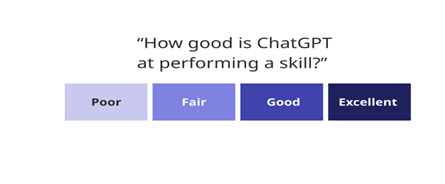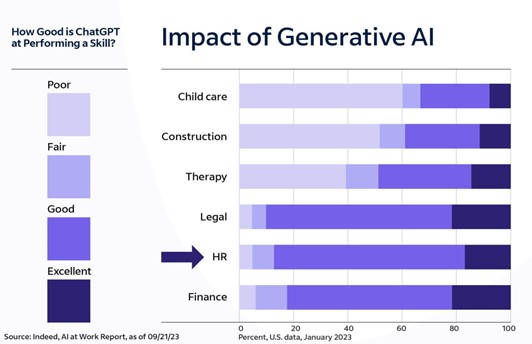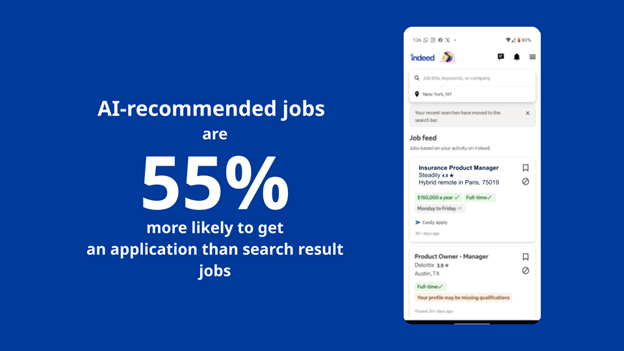Indeed: ‘We can have simpler, faster, more human hiring in the AI era’
At the UNLEASH World Conference in Paris, Indeed shared how responsible AI can build better work.
HR Leader Insight
The impact of AI on the labor market is both concerning and exciting.
Deployed responsibly, AI can help reduce unconscious bias.
Indeed is using the technology to make hiring simpler, faster, and more human, says Filippo Bonsanti Indeed VP of global marketing.
At Indeed, we strive to make hiring simpler, faster and more human. The future of work, however, is changing quickly, and now a major source of uncertainty has arisen: artificial intelligence (AI).
So how will AI impact the future of work — and how can a responsible approach to AI make hiring more human than ever?
1. The impact of AI on the labor market is both concerning and exciting
Right now, there is no bigger question than whether AI will help or hurt the world of work. Over the long run, technology has had a positive impact on humanity: Today, we work fewer hours, in safer conditions, and by nearly all measures enjoy a higher quality of life than ever.
But each cycle of disruption can cause some workers to lose their livelihood. And these cycles of disruption are happening faster and faster. With AI, it’s conceivable that students and apprentices might now find themselves learning skills today that will be obsolete by the time they graduate.
Put another way: AI gives people who thought their jobs were safe from automation the existential sweats.
As research from Indeed’s Hiring Lab shows, AI will transform jobs in sometimes unexpected ways:
Indeed Hiring Lab asked ChatGPT how good it was at performing a variety of skills.

The darker colors on this chart show skills that ChatGPT performs well, the lighter colors where it performs poorly. Jobs like child care and construction appear less affected since they typically need physical or face-to-face interactions. Sectors like legal, finance and HR might be more affected.
This doesn’t mean those jobs are likely to be replaced. But it does suggest they will change dramatically in the coming years.

Moreover, if left unchecked, AI has the potential to build a future workforce that is less inclusive, less diverse and that sustains barriers to entry for disadvantaged groups.
But at Indeed, we believe there’s a positive way forward; we are both concerned and excited about the impact of AI on the labor market.
Our chief concern is bias. AI is built from data. Data comes from humans.
Humans, unfortunately, are far from perfect. And we know, especially in our field, that significant bias and barriers exist in hiring.
For example, the Institute of Labor Economics sent out the resume of a fictitious woman to almost 1,500 companies. The resumes were identical, but on some, the researchers gave the woman a foreign-sounding name and attached a photo of her wearing a headscarf, while on others, they gave her a more traditional name and a photo without a headscarf.
The results were sobering: The researchers had to send out 4.5 times more resumes for the woman with the foreign-sounding name and wearing a headscarf in her photo to get the same number of callbacks as the other persona. When AI models are built from data with embedded bias like this, those models encode, replicate and scale that bias.
2. Deployed responsibly, AI can help reduce unconscious bias
While AI has the potential to contribute to bias and inequality, we see a promising path forward.
At Indeed, we are committed to ensuring that AI is, in fact, used to reduce these biases. We have made a significant commitment to Responsible AI practices, which can ultimately help reduce inequalities in hiring — whether it’s for applicants with disabilities, people with a criminal record or underrepresented minorities. We just have to be willing to ensure that AI enhances — rather than harms — fair hiring practices.
At Indeed, Responsible AI means that we are focused on keeping humans at the center of everything.
We believe that integrating AI into the hiring process can make recruiters better at their jobs. We all live with unconscious bias, whether we realize it or not. But if AI is used responsibly, it can reveal potential candidates that may not have been considered otherwise.
In short: AI can help Indeed deliver on our mission to make the hiring process simpler, faster and more human.
3. Indeed is using technology to make hiring more human
At Indeed, AI has helped power extraordinary improvements in matching job seekers to jobs.
Let’s start with pay.
When a job seeker views a job posting, our AI uses hundreds of millions of salary data points to estimate the pay for the job, and it helps the job seeker see how that pay matches their expectations.
And when an employer posts a job, our AI leverages data about every job and job seeker on Indeed to help them see how many applications they are likely to get and recommends the right budget to meet their hiring needs.
Indeed’s AI also turbocharges job search and matching in new and even more exciting ways. When a job seeker visits Indeed, they don’t even need to search. Our recommendation AI delivers each job seeker a personalized feed of their best job matches.
And job seekers love these jobs. In fact, they are 55% more likely to apply to an AI-recommended posting than one they see in search results.

And when employers post a job on Indeed, our AI recommends candidates that match their requirements — before candidates even see the job description. Employers can then choose the candidates that are the best fit and invite them to apply with a single click.
Another example: For many years, we have heard that one of the most difficult and time-consuming tasks in hiring is writing job descriptions. In response to this feedback, we have spent the past two years building and fine-tuning an AI-powered job description generator that is incredibly simple and effective.
We automatically propose an optimized ‘job title’ in order to attract more applicants and recommend relevant requirements, contract types, hours, pay and other criteria. Generative AI then creates a job description that employers can use or edit or regenerate to see additional options.
This can take generating a typical job description from two hours down to mere seconds.
And it works: Jobs that used our AI-driven job description generator get an average of 16% more applications.
We will also be debuting our latest AI offerings in the coming months. Once you find the right candidate, you can use our AI-powered Smart Message feature. It uses generative AI to automatically compose a personalized message to the job seeker explaining why your job is just right for them. You can also use AI to customize the message further and make it shorter, longer, more formal or more casual.
Allowing people to join forces with AI works: AI + human job descriptions get 1,700% more applicants than traditional job listings. We know firsthand that it’s best to keep humans in the loop.
We’re not trying to build a recruiting robot to replace humans.
We want to build a Tony Stark-style Iron Man suit that helps recruiters become more effective, so that they can spend more time establishing human connections with their candidates.
We are combining the power of AI with the power of human judgment in ways that are smart, fast and incredibly effective — so that the world can work better.
This story is adapted from Filippo Bonsanti’s presentation at the UNLEASH World Conference on October 17, 2023.
Sign up to the UNLEASH Newsletter
Get the Editor’s picks of the week delivered straight to your inbox!

VP of global marketing
Filippo Bonsanti is the VP of global marketing at global hiring and talent acquisition specialist Indeed.
-
Topics
Artificial Intelligence
